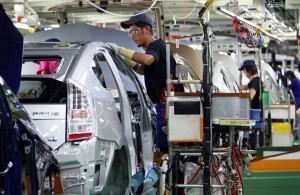
Toyota is struggling to make up production of the Prius lost due to Japan's March 11 earthquake and tsunami.
With operations at most of Japan’s automotive supplier and assembly plants starting to return to normal, manufacturers are putting out the Help Wanted signs as they race to make up for lost production.
Toyota and Honda alone expect to add up to 5,000 temporary workers in a bid to boost their output during the second half. Other makers, including Nissan, plan to hire new workers, as well.
Toyota now hopes that it can add an extra 350,000 vehicles to its assembly schedule during the second half of the fiscal year ending next March, said Senior Managing Director Takahiko Ijichi, which would reduce its overall production losses to about 450,000 cars, trucks and crossovers.
The maker’s Japanese plants are now back to 90% of their normal capacity and should reach full production by July – with U.S. factories expected to reach 100% in the coming weeks, Toyota marketing manager Ed LaRoque confirmed yesterday.
That’s a sharp turnaround from the weeks after the March 11 earthquake and tsunami struck the island nation. Most of the domestic industry was shut down for the first month after the disaster and a shortage of Japanese-made parts began to impact overseas “transplant” assembly lines, as well. Overall,production at home market plants tumbled 60% in April, though it hit 78% for Toyota, which has maintained a larger base of operations in Japan than its primary competitors.
The shortfall has had a serious impact on a variety of vehicle programs, leaving Honda with a severe shortage of the new, 2012 Civic model. Toyota, meanwhile, will delay “by several months” the launch of the new Prius v, the wagon-like hybrid that will help launch a new “family” of Prius-badged vehicles, LaRoque confirmed. The American introduction is now tentatively scheduled for October.
The executive also noted that despite efforts to boost production of the original Prius , U.S. dealers have less than a 4-day supply of the hybrid on hand. That resulted in an estimated 30% to 40% shortfall in Prius sales during May, LaRoque estimated. (Click Here for the full story.)
Toyota began hiring temporary workers in March, even as its plants were struggling to restart. It will continue adding workers up to about 4,000 in total, the maker said. Toyota officials also noted that most key suppliers are now operating at least at a reduced level. That includes Renasas, one of the world’s largest producers of automotive microcontrollers. At peak, Toyota was struggling with shortages of as many as 500 different parts. That is now down to 30, the maker said.
Nonetheless, the long-term impact is expected to be severe. Toyota’s Ijichi revealed, earlier this month, that the maker anticipates earnings for the current fiscal year to fall about 31%, to $3.5 billion. That reflects not only the production problems caused by the March disaster but also rising raw materials costs and the impact of a weakened U.S. dollar.
Honda and most other Japanese makers blame similar concerns for projected declines in their own earnings.
